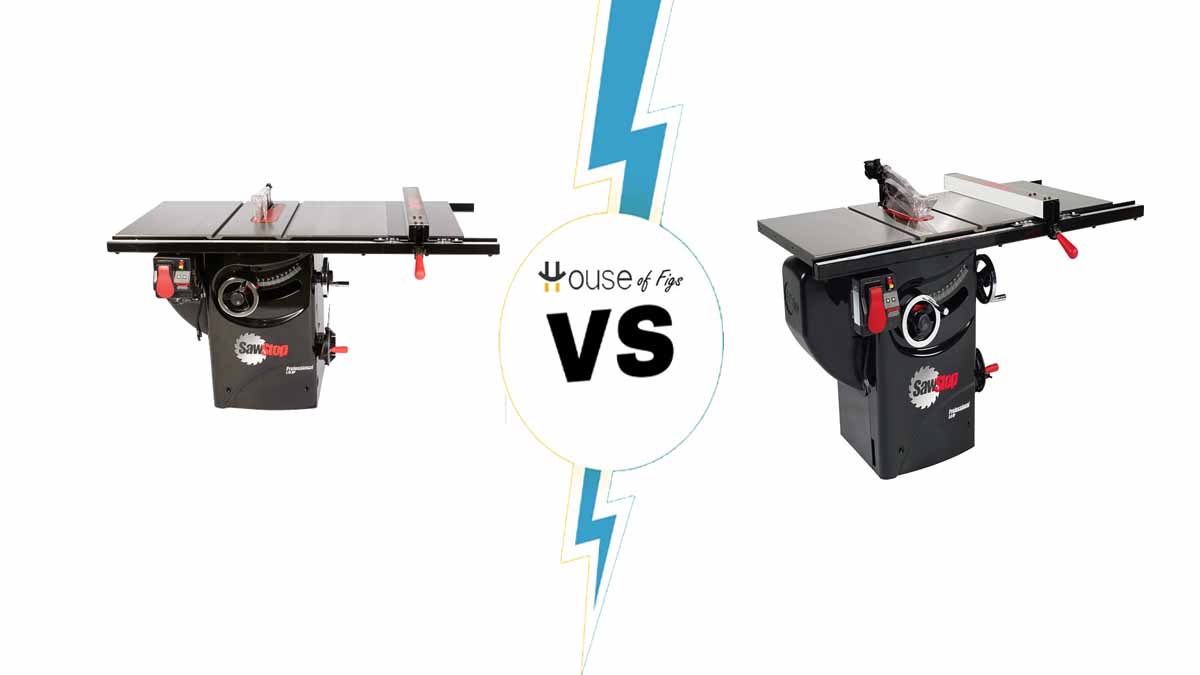3-HP Vs. 1.75-HP SawStop – Differences, Features, Pros and Cons
The Differences Between 3-HP vs. 1.75-HP SawStop: When comparing the 3-HP and 1.75-HP SawStop, there’s a notable contrast. Let’s find out the details.
3-HP Vs. 1.75-HP SawStop: Quick Comparison
| Features | 3-HP SawStop | 1.75-HP SawStop |
|---|---|---|
| Motor Power | 3 Horsepower | 1.75 Horsepower |
| Performance | Superior for hardwood | Suitable for softer woods |
| Price | Typically higher | More affordable |
| Electric Demand | Requires 220V | Requires 110V |
| Weight | Heavier | Lighter |
What Are The Key Differences Between 3-HP Vs. 1.75-HP SawStop?
Understand Motor Strength
A 3-HP SawStop boasts a motor with 3 horsepower. On the other hand, the 1.75-HP SawStop offers 1.75 horsepower. This difference in power affects their performance.
Assess Performance in Cutting
Given its greater power, the 3-HP SawStop excels in handling hardwood. It cuts through dense materials more efficiently. Conversely, the 1.75-HP SawStop, with its lesser power, is best suited for softer woods.
Evaluate the Price Point
Pricing reflects the capabilities. The 3-HP SawStop usually comes with a higher price tag. The 1.75-HP SawStop offers a more budget-friendly option.
Consider Electric Requirements
Electricity demand varies between these saws. The 3-HP model requires 220V for operation. In contrast, the 1.75-HP model works on 110V. Think about your workshop’s electric setup before choosing.
Weigh the Machines
The 3-HP SawStop typically weighs more. It’s robust and sturdy. The 1.75-HP SawStop, being lighter, is more manageable and easier to move around.
Choose Based on Your Needs
Your project determines your saw. For heavy-duty, frequent projects, the 3-HP SawStop is more appropriate. However, for less demanding tasks, the 1.75-HP SawStop suffices.
Key Takeaways:
- 3-HP SawStop has a stronger motor, making it ideal for hardwoods.
- 1.75-HP SawStop is more suited for softer woods due to its lesser motor strength.
- Cost varies, with the 3-HP typically costing more.
- Electric requirements differ: 220V for 3-HP and 110V for 1.75-HP.
- The 3-HP model is generally heavier than its 1.75-HP counterpart.
- Choose your saw based on project requirements and electrical availability.
Pros and Cons of 3-HP And 1.75-HP SawStop
When you’re diving into the world of woodworking, choosing the right equipment is vital. The 3-HP and 1.75-HP SawStop models are popular choices. So, let’s explore their advantages and disadvantages to make an informed decision.
Pros of 3-HP
- Superior Power: The 3-HP SawStop has a stronger motor. This means it can tackle harder woods effortlessly.
- Durability: With its robust construction, it lasts longer. It’s built for heavy-duty use.
- Smooth Operation: You’ll experience less resistance when cutting. It gives cleaner cuts, especially on thick materials.
- Flexibility: The added power lets you handle diverse projects. Whether it’s dense oak or soft pine, this machine is ready.
Cons of 3-HP
- Higher Cost: Quality comes at a price. The 3-HP model is generally more expensive than its counterpart.
- Increased Electric Demand: It needs 220V to operate. This might require an upgrade to your workshop’s electrical setup.
- Heavier: Its weight makes it less portable. Moving it around can be challenging.
- Space Consuming: Given its size, it demands more space in your workshop.
Pros of 1.75-HP SawStop
- Affordability: The 1.75-HP SawStop usually has a friendlier price tag. Great for those on a budget.
- Less Electric Demand: It operates on 110V. Most home workshops can accommodate this without any changes.
- Portable: Being lighter, it’s easier to relocate. If you have a mobile work setup, this is ideal.
- Perfect for Beginners: Its user-friendly interface and power are suitable for those starting in woodworking.
Cons of 1.75-HP SawStop
- Limited Power: It struggles with very dense materials. Hardwoods can pose a challenge.
- Less Durability: While still sturdy, it’s not built for super frequent heavy-duty use.
- Possible Rougher Cuts: On some materials, it may not deliver as clean a cut as the 3-HP model.
- May Need Upgrades: If your projects grow in complexity, you might find yourself needing a more powerful saw soon.
3-HP Vs. 1.75-HP SawStop – Which Should You Choose?
The decision between 3-HP and 1.75-HP SawStop boils down to your individual needs.
Evaluate Your Projects: What materials will you frequently work with? If it’s mostly hardwood, the 3-HP may be better. For softer woods, the 1.75-HP can be adequate.
Check Your Budget: Money matters. If you’re on a tight budget, the 1.75-HP SawStop gives good value. But if you can invest more upfront, the 3-HP can be a worthy investment.
Assess Your Workspace: Do you have the space and electrical setup for a larger machine? If not, the 1.75-HP SawStop might be more feasible.
Think Long-Term: While the 1.75-HP is excellent to start with, think about future needs. If you see yourself diving deep into woodworking, the 3-HP might serve you longer.
Always prioritize safety. Both saws come with the SawStop safety feature. Ensure you understand and use it correctly.
Conclusion: 3-HP Vs. 1.75-HP SawStop
- 3-HP SawStop offers superior power, durability, and can handle diverse materials but comes at a higher cost and needs more space.
- 1.75-HP SawStop is more budget-friendly, portable, and great for beginners but might struggle with denser materials.
- Both models prioritize user safety with the SawStop safety feature.
FAQs
What are the main differences in a 3-HP vs. 1.75-HP SawStop review?
The 3-HP offers more power, is better for hardwoods, and is generally heavier and more expensive. The 1.75-HP is more affordable, lightweight, and is suitable for softer woods.
What are people saying about SawStop 1.75 vs 3 HP on Reddit?
On Reddit, users often debate the merits of both, with the consensus leaning towards choosing based on project needs, workspace, and budget.
Are there any specific discussions on 3 HP vs 1.75 HP SawStop in forums?
Yes, many woodworking forums have discussions where users share personal experiences and offer insights on both models’ performance.
How do users rate the SawStop 1.75 HP in reviews?
The 1.75-HP is often praised for its affordability, portability, and suitability for beginners, although some mention its limitations with harder woods.
What’s the specification of SawStop 3HP?
The SawStop 3HP offers three horsepower, requiring 220V and typically weighs more than the 1.75-HP variant.
How many horsepower is a SawStop contractor saw?
A SawStop contractor saw typically comes with 1.75 horsepower.
How many amps is a Sawstop 3HP?
The SawStop 3HP motor typically draws around 13 amps when running on 220V.
How much does a 3HP Sawstop weigh?
The 3HP SawStop is heftier, with its weight varying based on the model and attached accessories, but it’s generally heavier than the 1.75-HP model.
What power does a Sawstop need?
A SawStop’s power requirement varies by model. The 1.75-HP requires 110V, while the 3-HP requires 220V.
Is a SawStop worth the price?
Many woodworkers believe that a SawStop is worth the price due to its safety features and performance, but the value can depend on individual needs and projects.
How does SawStop work so fast?
SawStop’s safety system detects contact with skin, triggering a brake mechanism that stops the blade within milliseconds, reducing the risk of serious injury.


